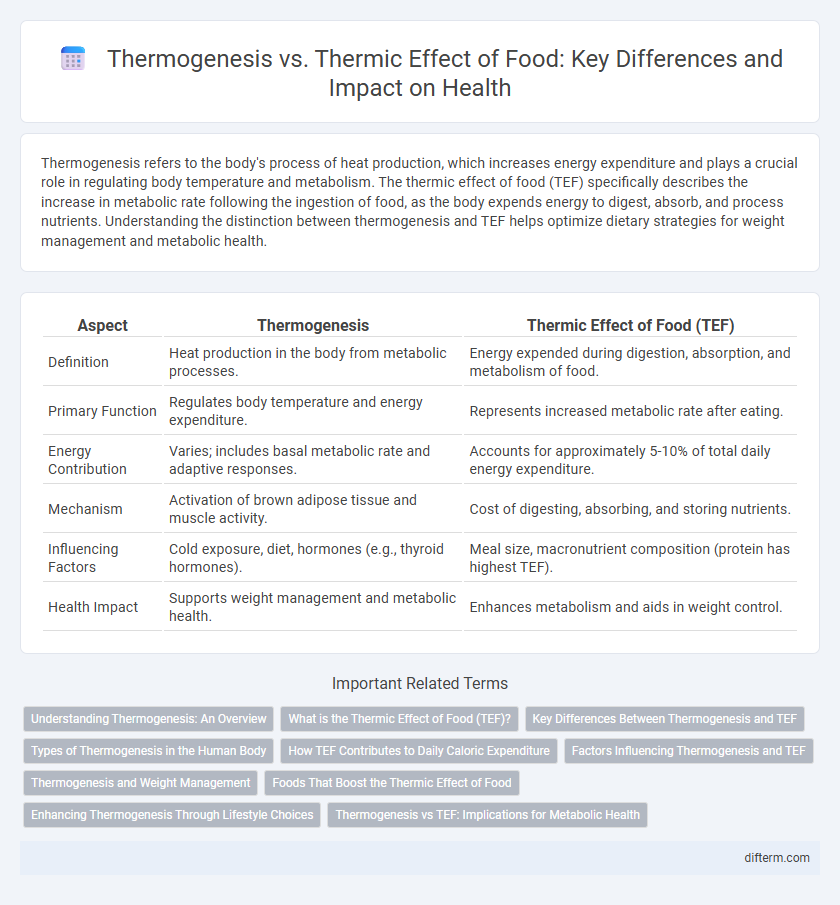Thermogenesis refers to the body's process of heat production, which increases energy expenditure and plays a crucial role in regulating body temperature and metabolism. The thermic effect of food (TEF) specifically describes the increase in metabolic rate following the ingestion of food, as the body expends energy to digest, absorb, and process nutrients. Understanding the distinction between thermogenesis and TEF helps optimize dietary strategies for weight management and metabolic health.
Table of Comparison
| Aspect | Thermogenesis | Thermic Effect of Food (TEF) |
|---|---|---|
| Definition | Heat production in the body from metabolic processes. | Energy expended during digestion, absorption, and metabolism of food. |
| Primary Function | Regulates body temperature and energy expenditure. | Represents increased metabolic rate after eating. |
| Energy Contribution | Varies; includes basal metabolic rate and adaptive responses. | Accounts for approximately 5-10% of total daily energy expenditure. |
| Mechanism | Activation of brown adipose tissue and muscle activity. | Cost of digesting, absorbing, and storing nutrients. |
| Influencing Factors | Cold exposure, diet, hormones (e.g., thyroid hormones). | Meal size, macronutrient composition (protein has highest TEF). |
| Health Impact | Supports weight management and metabolic health. | Enhances metabolism and aids in weight control. |
Understanding Thermogenesis: An Overview
Thermogenesis refers to the process of heat production in organisms, playing a crucial role in metabolic rate regulation and energy expenditure. It includes mechanisms such as shivering thermogenesis and non-shivering thermogenesis, primarily driven by brown adipose tissue activation. Understanding thermogenesis is essential for insights into weight management, metabolic health, and how the body balances energy intake and output.
What is the Thermic Effect of Food (TEF)?
The Thermic Effect of Food (TEF) refers to the increase in metabolic rate after ingestion of food, accounting for approximately 5-10% of daily energy expenditure. TEF involves energy used for digestion, absorption, and nutrient processing. It varies by macronutrient type, with protein eliciting the highest TEF, followed by carbohydrates and fats.
Key Differences Between Thermogenesis and TEF
Thermogenesis refers to the body's process of heat production through metabolic activities including shivering and non-shivering mechanisms, while the thermic effect of food (TEF) specifically describes the energy expended to digest, absorb, and metabolize nutrients. Thermogenesis encompasses a broader range of physiological responses such as adaptive thermogenesis and diet-induced thermogenesis, whereas TEF is a subset focused solely on metabolic increase after eating. The key difference lies in thermogenesis being a comprehensive heat generation process, whereas TEF quantifies the caloric cost related exclusively to food intake.
Types of Thermogenesis in the Human Body
Thermogenesis in the human body primarily includes shivering thermogenesis, which generates heat through muscle contractions, and non-shivering thermogenesis, involving brown adipose tissue activation to produce heat without muscle activity. Diet-induced thermogenesis, also known as the thermic effect of food, increases metabolic rate by energy expenditure required for digestion, absorption, and nutrient processing. Adaptive thermogenesis adjusts heat production based on environmental temperature changes and calorie intake, playing a crucial role in energy balance and weight regulation.
How TEF Contributes to Daily Caloric Expenditure
The thermic effect of food (TEF) accounts for approximately 10% of daily caloric expenditure by increasing energy required for digestion, absorption, and nutrient metabolism. Unlike thermogenesis, which includes heat production from various physiological processes like shivering or non-shivering mechanisms, TEF specifically boosts metabolic rate following food intake. Understanding TEF's role helps optimize diet planning for weight management by leveraging the energy cost of food processing.
Factors Influencing Thermogenesis and TEF
Thermogenesis is influenced by factors such as ambient temperature, physical activity, and hormonal regulation, including thyroid hormone and catecholamines, which enhance metabolic rate. The thermic effect of food (TEF) varies with macronutrient composition, with protein inducing the highest TEF, followed by carbohydrates and fats due to differing energy costs of digestion, absorption, and nutrient metabolism. Individual factors like age, body composition, and genetic predisposition also modulate both thermogenesis and TEF, affecting total daily energy expenditure.
Thermogenesis and Weight Management
Thermogenesis plays a crucial role in weight management by increasing energy expenditure through heat production in the body, which helps burn more calories even at rest. Brown adipose tissue (BAT) is a key contributor to thermogenesis, as it converts stored fat into heat, thereby aiding in reducing body fat and improving metabolic health. Enhancing thermogenic activity through cold exposure, exercise, or dietary components like capsaicin can support fat loss and optimize weight control strategies.
Foods That Boost the Thermic Effect of Food
Foods rich in protein, such as lean meats, eggs, and legumes, significantly boost the thermic effect of food (TEF) by increasing calorie expenditure during digestion. Spicy foods containing capsaicin, like chili peppers, enhance thermogenesis, temporarily raising metabolic rate and energy burn. Green tea and coffee provide bioactive compounds like catechins and caffeine that stimulate metabolism and support a higher thermic effect, promoting fat oxidation.
Enhancing Thermogenesis Through Lifestyle Choices
Enhancing thermogenesis through lifestyle choices involves increasing the body's heat production to boost metabolism and promote fat burning. Regular exercise, especially high-intensity interval training (HIIT), and exposure to cold temperatures stimulate brown adipose tissue activity, leading to greater energy expenditure. Consuming spicy foods containing capsaicin and ensuring adequate protein intake also elevate thermic effect of food, contributing to higher overall daily calorie burn.
Thermogenesis vs TEF: Implications for Metabolic Health
Thermogenesis and the thermic effect of food (TEF) both contribute to energy expenditure but differ in origin; thermogenesis includes processes like shivering and non-shivering heat production, while TEF specifically refers to the energy required to digest, absorb, and metabolize nutrients. Increased thermogenesis and higher TEF rates enhance metabolic health by boosting total daily energy expenditure and improving glucose regulation, potentially aiding obesity prevention. Understanding the balance between these mechanisms informs dietary and lifestyle strategies targeted at optimizing metabolic function and reducing metabolic disease risk.
Thermogenesis vs Thermic effect of food Infographic

 difterm.com
difterm.com